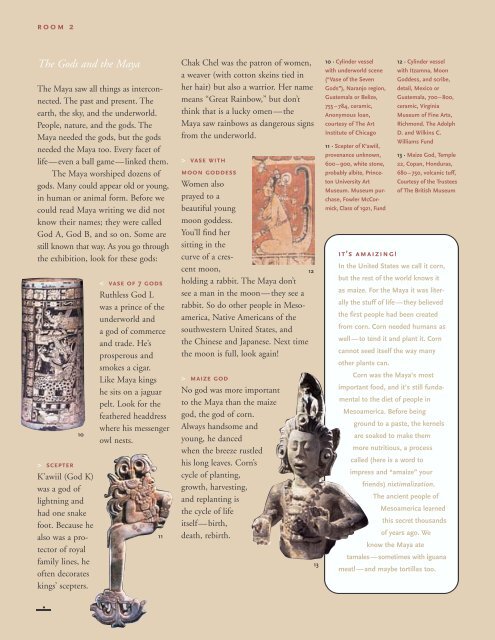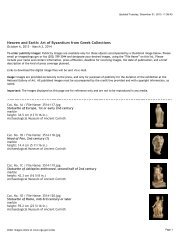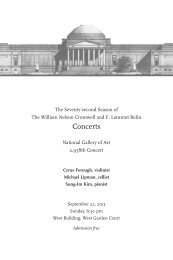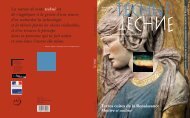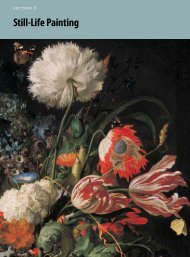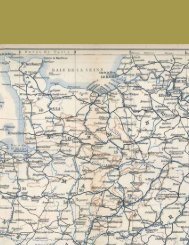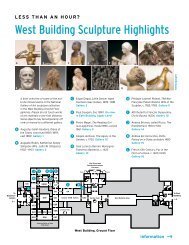Courtly Art of the Ancient Maya - National Gallery of Art
Courtly Art of the Ancient Maya - National Gallery of Art
Courtly Art of the Ancient Maya - National Gallery of Art
Create successful ePaper yourself
Turn your PDF publications into a flip-book with our unique Google optimized e-Paper software.
oom 2<br />
The Gods and <strong>the</strong> <strong>Maya</strong><br />
The <strong>Maya</strong> saw all things as interconnected.<br />
The past and present. The<br />
earth, <strong>the</strong> sky, and <strong>the</strong> underworld.<br />
People, nature, and <strong>the</strong> gods. The<br />
<strong>Maya</strong> needed <strong>the</strong> gods, but <strong>the</strong> gods<br />
needed <strong>the</strong> <strong>Maya</strong> too. Every facet <strong>of</strong><br />
life—even a ball game—linked <strong>the</strong>m.<br />
The <strong>Maya</strong> worshiped dozens <strong>of</strong><br />
gods. Many could appear old or young,<br />
in human or animal form. Before we<br />
could read <strong>Maya</strong> writing we did not<br />
know <strong>the</strong>ir names; <strong>the</strong>y were called<br />
God A, God B, and so on. Some are<br />
still known that way. As you go through<br />
<strong>the</strong> exhibition, look for <strong>the</strong>se gods:<br />
10<br />
> scepter<br />
K’awiil (God K)<br />
was a god <strong>of</strong><br />
lightning and<br />
had one snake<br />
foot. Because he<br />
also was a protector<br />
<strong>of</strong> royal<br />
family lines, he<br />
<strong>of</strong>ten decorates<br />
kings’ scepters.<br />
< vase <strong>of</strong> 7 gods<br />
Ruthless God L<br />
was a prince <strong>of</strong> <strong>the</strong><br />
underworld and<br />
a god <strong>of</strong> commerce<br />
and trade. He’s<br />
prosperous and<br />
smokes a cigar.<br />
Like <strong>Maya</strong> kings<br />
he sits on a jaguar<br />
pelt. Look for <strong>the</strong><br />
fea<strong>the</strong>red headdress<br />
where his messenger<br />
owl nests.<br />
11<br />
Chak Chel was <strong>the</strong> patron <strong>of</strong> women,<br />
a weaver (with cotton skeins tied in<br />
her hair) but also a warrior. Her name<br />
means “Great Rainbow,” but don’t<br />
think that is a lucky omen—<strong>the</strong><br />
<strong>Maya</strong> saw rainbows as dangerous signs<br />
from <strong>the</strong> underworld.<br />
> vase with<br />
moon goddess<br />
Women also<br />
prayed to a<br />
beautiful young<br />
moon goddess.<br />
You’ll find her<br />
sitting in <strong>the</strong><br />
curve <strong>of</strong> a crescent<br />
moon,<br />
12<br />
holding a rabbit. The <strong>Maya</strong> don’t<br />
see a man in <strong>the</strong> moon—<strong>the</strong>y see a<br />
rabbit. So do o<strong>the</strong>r people in Mesoamerica,<br />
Native Americans <strong>of</strong> <strong>the</strong><br />
southwestern United States, and<br />
<strong>the</strong> Chinese and Japanese. Next time<br />
<strong>the</strong> moon is full, look again!<br />
> maize god<br />
No god was more important<br />
to <strong>the</strong> <strong>Maya</strong> than <strong>the</strong> maize<br />
god, <strong>the</strong> god <strong>of</strong> corn.<br />
Always handsome and<br />
young, he danced<br />
when <strong>the</strong> breeze rustled<br />
his long leaves. Corn’s<br />
cycle <strong>of</strong> planting,<br />
growth, harvesting,<br />
and replanting is<br />
<strong>the</strong> cycle <strong>of</strong> life<br />
itself—birth,<br />
death, rebirth.<br />
13<br />
10 · Cylinder vessel<br />
with underworld scene<br />
(“Vase <strong>of</strong> <strong>the</strong> Seven<br />
Gods”), Naranjo region,<br />
Guatemala or Belize,<br />
755 – 784, ceramic,<br />
Anonymous loan,<br />
courtesy <strong>of</strong> The <strong>Art</strong><br />
Institute <strong>of</strong> Chicago<br />
11 · Scepter <strong>of</strong> K’awiil,<br />
provenance unknown,<br />
600–900, white stone,<br />
probably albite, Princeton<br />
University <strong>Art</strong><br />
Museum. Museum purchase,<br />
Fowler McCormick,<br />
Class <strong>of</strong> 1921, Fund<br />
it’s amaizing!<br />
12 · Cylinder vessel<br />
with Itzamna, Moon<br />
Goddess, and scribe,<br />
detail, Mexico or<br />
Guatemala, 700–800,<br />
ceramic, Virginia<br />
Museum <strong>of</strong> Fine <strong>Art</strong>s,<br />
Richmond. The Adolph<br />
D. and Wilkins C.<br />
Williams Fund<br />
13 · Maize God, Temple<br />
22, Copan, Honduras,<br />
680–750, volcanic tuff,<br />
Courtesy <strong>of</strong> <strong>the</strong> Trustees<br />
<strong>of</strong> The British Museum<br />
In <strong>the</strong> United States we call it corn,<br />
but <strong>the</strong> rest <strong>of</strong> <strong>the</strong> world knows it<br />
as maize. For <strong>the</strong> <strong>Maya</strong> it was literally<br />
<strong>the</strong> stuff <strong>of</strong> life—<strong>the</strong>y believed<br />
<strong>the</strong> first people had been created<br />
from corn. Corn needed humans as<br />
well—to tend it and plant it. Corn<br />
cannot seed itself <strong>the</strong> way many<br />
o<strong>the</strong>r plants can.<br />
Corn was <strong>the</strong> <strong>Maya</strong>’s most<br />
important food, and it’s still fundamental<br />
to <strong>the</strong> diet <strong>of</strong> people in<br />
Mesoamerica. Before being<br />
ground to a paste, <strong>the</strong> kernels<br />
are soaked to make <strong>the</strong>m<br />
more nutritious, a process<br />
called (here is a word to<br />
impress and “amaize” your<br />
friends) nixtimalization.<br />
The ancient people <strong>of</strong><br />
Mesoamerica learned<br />
this secret thousands<br />
<strong>of</strong> years ago. We<br />
know <strong>the</strong> <strong>Maya</strong> ate<br />
tamales—sometimes with iguana<br />
meat!—and maybe tortillas too.


